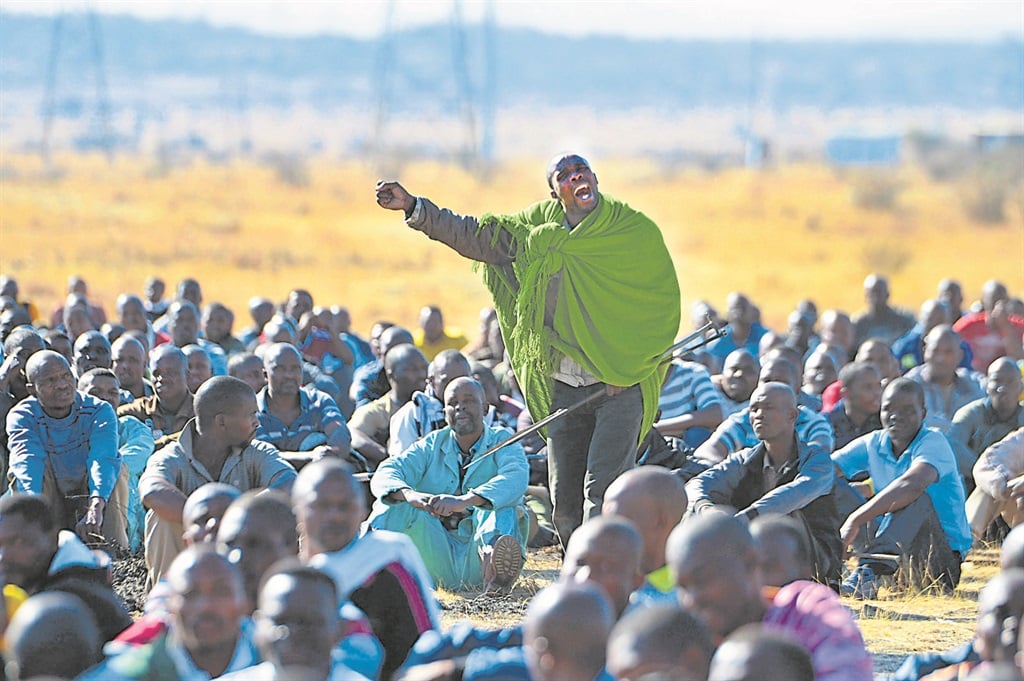
No one was killed on this day in 2012 during the wildcat strike at the Lonmin platinum mine in Marikana in North West. But no one could have guessed what would happen the following day, although at least 10 people had already been killed a few days earlier.
The strike’s momentum was escalating, with a crowd of about 3 000 striking mine workers converging on the now infamous Marikana koppie and overflowing to its foot. Armed with knobkerries and sharp objects, they spent their day dancing, singing and chanting slogans, but little did they know that some of them were seeing the sunset for the last time.
On August 16 2012, the world witnessed, some on live TV, the killing of at least 16 mine workers near a kraal on the edge of the Nkaneng informal settlement, later referred to by investigators as scene one. Later, it was discovered that 18 more were killed at a smaller koppie about 500m away – later known as scene two.
The National Prosecuting Authority (NPA) said these two scenes formed two “big cases under consideration which can be referred to as the main Marikana cases involving incidents of killing of mine workers by the police on August 16 2012 at two adjacent hillocks near the Nkaneng informal settlement”.
“Scene one relates to the shooting incident of mine workers by the police, which was captured and widely reported on by the media,” said NPA spokesperson Mthunzi Mhaga.
“However, scene two, a sequel of scene one, is relatively unknown to the outside world because it happened away from the glare of the media. At scene two, it is alleged that the police rounded up the mine workers who were fleeing from them and shot them execution style,” Mhaga said.
He said the case dockets for scene one and scene two were “still under investigation by the Independent Police Investigative Directorate [Ipid]”, adding that “Ipid has not completed the investigation to date because they claim to have severe capacity constraints in terms of investigators”.
“Currently, only two investigators remain from the original seven when the investigations commenced in 2015, after the release of the Farlam commission report [into the massacre],” he said.
Meanwhile, the deaths of the 34 mine workers will be commemorated again tomorrow, but their families are yet to see justice, which many hope will bring them closer to finding closure.
READ: SA unrest: The historic context of the current riots and violence
While there were uncertainties about who would stand accused of killing the 34 men, at least four police officers were acquitted in March on charges related to the death of mine worker Modisaotsile Segalala in police custody. Segalala had reportedly sustained at least two gunshot wounds when he was shot at scene two.
Former North West deputy provincial police commissioner, William Mpembe, the former provincial head of detectives, Jacobus van Zyl, the provincial head of detectives, Brigadier Dingaan Madoda, and Lieutenant-Colonel Oupa Pule were acquitted on all charges.
“It was a case of defeating the ends of justice, where the state alleged that the police concealed the death of a mine worker in police custody.
“The body of the mine worker was discovered in a police truck at a temporary detention centre set up by the police on Lonmin mine premises,” Mhaga said.
“The police misled the Farlam commission by claiming that the mine worker died at a mine hospital and failed to report the death incident to Ipid as required by law. The state is considering an appeal on the questions of law on the basis of the belief that the court had erred.”
After being acquitted in the Segalala case, Mpembe still had one more case to answer. He and five other officers, including those who have since left the SA Police Service – as he has – made their last appearance in the Mahikeng High Court last week.
The charges against them included five counts of murder, attempted murder and defeating and/or obstructing the ends of justice by giving wrong information to the Marikana commission of inquiry.
The charges are in connection with the deaths of the six officers’ two colleagues and three mine workers who were killed during a clash between the police on August 13. The matter was postponed to November and was set down to be heard until December 2.
Another case related to the 2012 Marikana massacre is that of the strike leader Anele Zonke and 17 others, who are charged with a number of murders during the bloody strike.
“The accused are facing 24 counts comprising murder, attempted murder, malicious damage to property, robbery and possession of both unlicensed firearms and ammunition. This case is concerned solely with incidents that preceded the Marikana tragedy of August 16 2012 and does not consist of any of the incidents of that day,” Mhaga said.
READ: Mmusi Maimane | Looking to a post-ANC that works
The Socioeconomic Rights Institute of SA (Seri) said the inaction in terms of getting justice for the dead was adding to the trauma experienced by the families of the Marikana victims.
“Since 2012, the families and surviving mine workers have continued to bear the trauma and loss, which has been compounded by the lack of justice and accountability for the events at Marikana.
“To date, only nine police officers have been charged [and] no one has been charged for and prosecuted for the deaths of the mine workers killed on August 16 2012,” Seri said.




 Publications
Publications
 Partners
Partners











